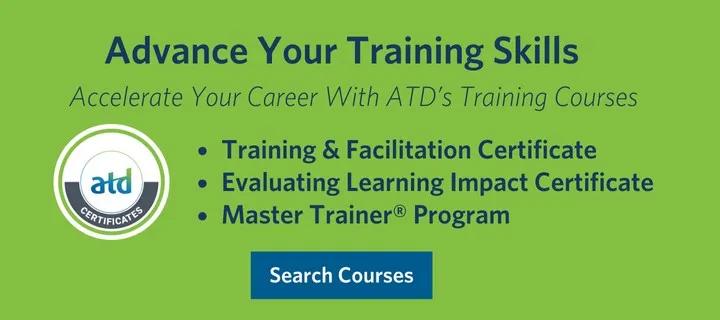ATD Blog
5 Tips for Returning Back to In-Person Facilitation
Even the most experienced facilitators often find it takes time to get used to large, in-person settings again after a long stint of solely virtual work.
Mon Jan 06 2025

Did you switch to virtual facilitation in the past, only to now find yourself returning to in-person? Did that shift feel clunkier than you’d expected? Not to worry—you’re not alone. Even the most experienced facilitators often find it takes time to get used to large, in-person settings again after a long stint of solely virtual work. Recently, I was brought in to coach some trainers whose in-person facilitation skills had “gotten rusty” as they’d transitioned to primarily virtual settings. Here are five tips I found myself sharing with several of the more experienced trainers I observed:
1. Watch where you place yourself in the room
Moving around isn’t something you have to consider much when facilitating virtual sessions. But in person you’ll want to keep it top of mind. Effective facilitators pause and re-position themselves in different sections of the room throughout the event. Pausing before moving means you’re not moving while talking (aka pacing). You can also facilitate from the sides of the room, or even the back, to make sure you’re connecting with folks throughout the space—and keeping participants alert.
And importantly, when a participant is speaking, remember to step away from them! When you move in closer to them, it can inadvertently turn into a conversation between just you and the participant, leaving anyone sitting farther away feeling left out. Stepping away from a speaker, while counter-intuitive, forces them to project their voice to be heard and opens the discussion to the whole room.
2. Don’t talk when they’re talking
Wait until everyone in the room is silent before beginning to speak or giving instructions—and I do mean everyone. For instance, if you’re talking while a few participants at one table in the back are also still chatting, it means fewer people will be able to focus on what you are saying. And that can lead to confusion and the need to repeat yourself.
3. Use techniques to elicit participation
Are you posing questions to the full group and hearing crickets, even after lively small group discussion? Here are three pro tips for encouraging participation:
Have a plant. During group activities, I often go to one of the quieter participants in the room and give them a response I want to hear during the debrief. I ask them if they’ll raise their hand and just repeat back what I’ve shared with them when we debrief. This “gets the ball rolling,” and allows the quiet participant to elaborate on what I told them to say, further engaging them.
Call on tables or quadrants of the room. Instead of throwing out, “What questions do you have?” to the entire room, say, “Table 5, what questions do any of you have?” or “Back of the room, what’s your reaction to what I just said?”
Say, “Let me hear from three of you.” When asking for input, state how many people you hope or expect to hear from. For example, “I’d like to hear from three of you before we go on,” or “Ask me three questions.” When they realize you’re not moving on until you’ve heard from that many people, the group often steps up.
Offer stretch breaks
To maintain attention from distracted minds, it’s recommended you give people a chance to move and stretch for a minute every half hour or so of instruction. During this break, I remind the group that this isn’t the time to leave the room or to try to catch up with email messages, but simply a quick opportunity to stretch and refocus. I also don’t give them a task to do during the stretch.
I’m always surprised how many people mention that this is something they especially appreciate about my sessions. NOTE: This is true for virtual facilitation as well!
Employ principles of Universal Design for Learning (UDL)
The UDL framework aims to create learning experiences that are accessible, inclusive, and equitable for everyone involved. Following UDL principles often leads to adjustments that are necessary for some learners but improve the experience for all learners as well.
An easy way to employ these principles is to offer multiple means of engagement and expression. For instance, provide choices of whether to reflect in small groups in one part of the room, or individually in another. An advantage of virtual delivery is the ability to allow quieter participants to contribute using chat or a poll. You can create the same experience in a live classroom. Let people respond by raising a hand and speaking, by submitting a note on an index card, or by raising a “Yes” or “No” indicator.
Flexible learning environments that support accessibility are also important. Examples include having in-place options for any activity that requires mobility, using microphones when presenting to make it easier for attendees to hear you clearly (yes, even if you’re great at projecting your voice), and using wall posters with key session models or content as visual reminders as well as supports for people who have difficulty seeing slides from where they’re sitting.
Welcome back to the live classroom! I hope these tips help make your re-immersion more effective.

